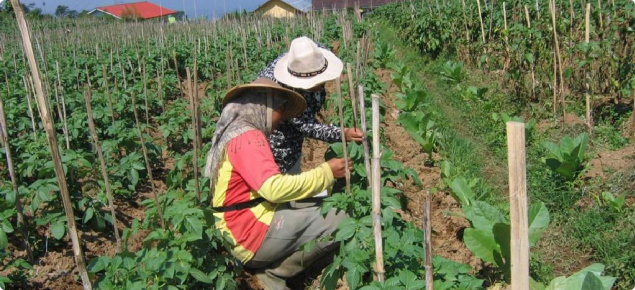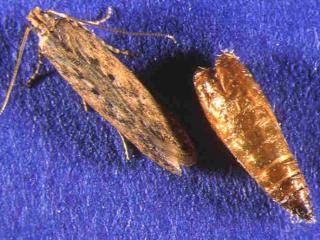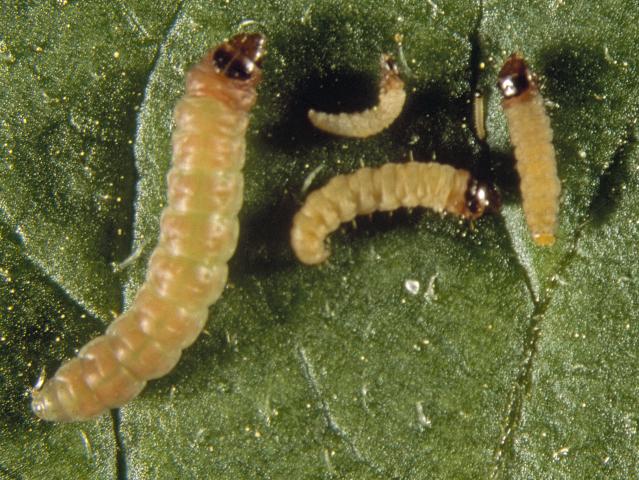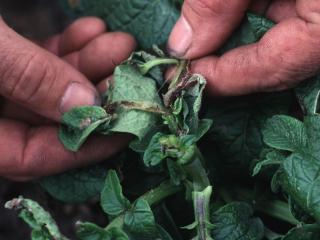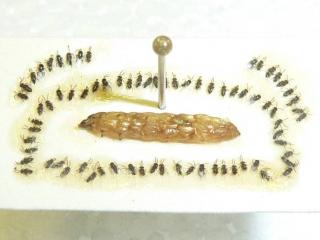Identification
Potato tuber moth’s Indonesian name is "ulat penggerek daun" and its scientific name is Phthorimaea operculella.
Potato tuber moth adults are about 8mm long with dark flecks on their wings. They can invade crops from early stages through to harvest. They also invade and infest stored tubers or stored seed potatoes. Adults lay eggs on leaves or exposed tubers.
Eggs hatch into larvae which feed within burrows they make in stems, leaves and tubers. Larvae have a black head and a pinkish area on the body just behind the head. Larvae wriggle quickly when removed from the leaf mine.
In young potato plants, larvae feed mainly within the stems or on growing tips which can kill them.
Mines caused by the potato tuber moth larvae within potato leaves are larger and fewer than the leaf mines caused by potato leafminer fly. Leaves damaged in this way reduce the vigour of potato plants and affect yield.
Potato tuber moth larvae can also burrow into tubers while the crop is still in the field and later when tubers are stored. Infested tubers show surface frass at the entrance of mines and mines near the surface can be seen as dark lines.
Potato tuber moth cocoons can often be seen in containers of infested potatoes.
Management
Potato tuber moth larvae attack crops such as potatoes, tomatoes and tobacco. They also feed on weeds in this plant group such as nightshade. It is important to destroy crop residues after harvest and control host weeds. Do not leave rejected potato tubers in the field where potato tuber moth can breed.
Potato tuber moth larvae can reduce a plant stand by boring into stems killing them. Infested leaves affect the vigour of crops resulting in reduced tuber yield.
Larvae feeding on tubers are even more damaging because this makes them unmarketable. If this pest is overlooked, the whole crop can be lost. Infested seed potatoes become a source of infestation in crops when planted.
Do not plant tubers infested with potato tuber moth larvae.
Some insects help control potato tuber moth. For example, some wasps attack and kill eggs or larvae within leaves.
Two important species in Western Australia are Orgilus and Copidosoma. When an Orgilus wasp stings a potato tuber moth larva, only one parasite emerges after the tuber moth larva dies. When a Copidosoma wasp stings a tuber moth larva, many offspring emerge from the larva.
Monitor for wasp parasites by holding potato leaves infested with potato tuber moth larvae in jars with gauze covers for three weeks. Adult wasps like those pictured here will emerge. The relative numbers of wasp parasites and potato tuber moths shows how many wasps are present in the potato crop.
Monitor crops weekly by checking 50 stems and leaves across the crop.
In young crops spray when 10% of stems are damaged by potato tuber moth larvae, or five of 50 stems have live larvae in stems.
In advanced crops spray at 20% leaves with live larvae in leaf mines; 10 of 50 leaves with mines.
Dry soil exposes any growing tubers to infestation by adult or larvae potato tuber moth. Hilling up the crop rows uses the soil to protect developing or mature tubers from attack. If possible keep tubers covered with soil and keep the soil well watered.
In harvested tubers, check 100 tubers throughout the store. Protect tubers if at least five are infested with live potato tuber moth larvae.
Check stored tubers every week to make sure they do not become infested.
Acknowledgment
Funding for this work to support Indonesian potato farmers and WA seed potato exports was provided by ACIAR (the Australian Centre for International Agricultural Research) and the Department of Agriculture and Food, Western Australia.


